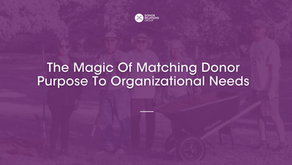Gratitude, Grace, and the Gift That Changed Us All
- Lynne Wester
- Sep 10
- 4 min read

If you asked me why I love Donor Relations work, I could give you so many reasons. I love finding ways to express gratitude. I love sharing information about our donors' gifts. I love celebrating their generosity. I love surprising and delighting the donor. I love finding unique ways to further engage donors. I love building loyalty.
BUT what I love the most is getting to know the donor in such a way that I understand them, their motivation for giving, and their genuine 'why' statement. When you know someone’s why, you can connect with them on an entirely different level.
Let me share this great story to illustrate my point. It all began back in 2012. I was a new employee. I had been recruited because the organization was struggling with major stewardship issues. They needed someone who could come in and build a donor relations program. For someone like me, who loves to build things, this was truly a dream assignment.
About three months into this new position, I had learned enough about the program to see that things were a mess. I was asked by my leadership to share my plans with the trustees at a board meeting. I stood up there and laid out my plan, explained why donor relations was so important, and then opened it up to questions. It was then that this woman in the back of the room raised her hand. She had been scowling at me throughout the entire presentation, and once I even heard her audibly scoff at something I had said.
So, I braced myself and called on her. She proceeded to stand up in front of everyone and tell me about a check she had written several months ago that had been lost by our organization. She paused for effect, and then said it was for $1 million. Now, the audience gasped, and their eyes were all on me to see what I would say or do.
This woman was angry and rightfully so. My first response was to apologize and acknowledge that this type of error was inexcusable. I then asked her if she would help me fix the problem. She was shocked by my request, and asked why she should. And I told her that our systems were broken, I needed people like her—loyal and committed donors—to help me build a program to ensure this never happened to another donor. She agreed on the spot, and in that moment, we created the organization’s first-ever stewardship committee.
We worked together for years, building a program that we could be extremely proud of, and one that ensured mistakes like lost checks would never happen again. While we were working together, I began to ask her questions, and slowly over time, her relationship with our organization was repaired and rebuilt. I learned why she made her first gift—and why she chose to expand her giving. I learned why she made the decision to donate a million dollars—to create a study abroad scholarship.
She told me how her life had been changed forever because of her own experience studying and traveling abroad. She said it was not just her perspective about the world, but how she had grown in independence and confidence. That trip—that experience—had been a defining moment in her life. One that was so important, she wanted to ensure other students could have the same opportunity.
A few years later, this donor fell gravely ill. We made plans to surprise her and bring the entire class of students who had just returned from their study abroad program to her home, so she could meet them and hear all about their experiences. However, we learned from her family that she was too ill to have that many visitors. So, we recorded interviews with the students, and created a video that we hoped would demonstrate how she had changed their lives.
The students were amazing, they were honest, grateful, and vulnerable, sharing stories meant for this donor only. I was crying while recording these moments she made possible. We did minor editing only, and sent our Chancellor to visit her and show her the video. The donor was so ill our Chancellor had to show it to her on her iPad while the donor laid in bed.
Our donor’s reaction was just as I had hoped it would be—she laughed and cried as she heard each student's experience. When the video was over, she grabbed the Chancellor's hand and thanked her for showing that her dream of helping others had been realized. Our goal was to thank the donor for what she did for our students, but it was our donor who thanked us for helping her accomplish something so incredibly important to her. What a moment, what a lesson—it was truly one that changed us all.
As life turns out, this amazing woman lost her battle a few weeks later, and left almost the entirety of her estate to our organization. Her final gift allowed us to name a performing arts center in her honor—the first building ever to be named for a woman on our campus.
Had it not been for that fateful meeting, I highly doubt that we would have received another gift from this donor, let alone one from her estate. Building the program with her gave us the chance to repair her relationship with our organization, get to know her better as an individual, and discover her ‘why’ behind her generosity.
Getting to know our donors, their motivations, and their ‘whys’ allows us to connect with them on a higher level, AND provide the bespoke stewardship that truly affects our donors and in turn, our missions and organizations.
Written by Angie Joens





